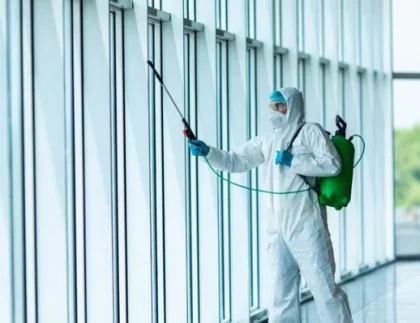
A competitive landscape of innovation and opportunity.
The car detailing industry has evolved significantly over the past decade, becoming a dynamic and fiercely competitive sector. In 2025, businesses are striving harder than ever to differentiate themselves in an increasingly saturated market. This article provides a comprehensive overview of the current state of the detailing industry, highlighting trends, challenges, opportunities and the innovations shaping its future. Additionally, it explores strategies entrepreneurs can use to gain financial traction, attract new clients and retain loyal customers in a competitive environment.
The current landscape of car detailing
The U.S. carwash and auto detailing industry are projected to reach a market size of $20.2 billion in 2025, representing a 1.9% increase from $19.8 billion in 2024.1 This growth reflects consumer demand for convenience, advanced vehicle care and eco-friendly solutions. While these trends persist, 2025 introduces heightened competition driven by rapid technological advancements, changing consumer preferences and innovative business models.
From traditional full-service detailing shops to mobile detailing units and automated systems, businesses are vying for market share. Meanwhile, informed consumers now compare quality, price and convenience before committing to a service provider, putting additional pressure on businesses to deliver exceptional value and differentiate themselves in creative ways.
Key trends shaping the industry
Advancements in technology
Technology remains the driving force behind transformation in the detailing industry. Innovations in equipment such as touchless pressure washers, steam cleaning systems and dry ice blasting machines have enhanced operational efficiency while reducing human error. Vehicle scanning technologies, including 3D sensors and advanced cameras, now allow detailers to assess a car’s condition with unparalleled accuracy, leading to tailored service recommendations.
Additionally, customer-focused digital tools are setting new benchmarks for convenience. Mobile apps and algorithm-driven platforms streamline appointment booking, payment processing and loyalty programs, making it easier than ever for businesses to attract and retain customers. Entrepreneurs investing in these tech-forward solutions are seeing increased customer satisfaction and operational efficiency.
Chemical innovation
The chemical side of detailing continues to see groundbreaking advancements. Ceramic and graphene coatings have become must-have offerings in premium detailing packages. Once considered niche, these coatings are now central to the market due to their long-lasting protection and hydrophobic properties. Graphene has emerged as the next big innovation, offering enhanced durability, heat dissipation and resistance to contaminants.
Waterless detailing products are also gaining popularity, combining environmental consciousness with convenience. Infused with lubricants and polymers, these products safely lift dirt without the need for rinsing, making them especially attractive in drought-prone areas.
Chemicals at the forefront
Ceramic coatings: Ceramic coatings form a durable, hydrophobic layer that chemically bonds with a vehicle’s clear-coat. These coatings shield paint from UV damage, stains, bird droppings and other contaminants while enhancing gloss. Premium ceramic coatings can last between two and five years with proper maintenance, offering customers both value and peace of mind.
Graphene coatings: Graphene, a carbon-based nanomaterial, is revolutionizing protective coatings. Its anti-water-spotting properties, superior scratch resistance and extended longevity make it a highly sought-after solution for detailing professionals. Graphene coatings can last up to seven years with minimal maintenance.
Nanotechnology-infused sealants: These sealants penetrate microscopic imperfections in paint to create smooth, protective barriers. Many advanced formulations also feature self-healing properties, which repair minor scratches when exposed to heat. Nanotechnology sealants offer a cost-effective alternative to ceramic and graphene coatings, making them an appealing option for budget-conscious consumers.
Waterless detailing products: As eco-friendly solutions gain traction, waterless detailing products are becoming essential. These sprays combine lubricants and polymers to lift dirt and grime, providing a convenient, sustainable alternative to traditional washes.
Challenges facing the industry
While the detailing industry presents exciting opportunities, it is not without its hurdles:
Price sensitivity: Customers often prioritize affordability over quality, forcing businesses to compete on price, which can erode profit margins.
Labor shortages: Skilled labor remains in short supply, with many businesses struggling to recruit and retain experienced detailers.
High consumer expectations: Social media and online reviews have amplified customer expectations. Negative feedback can spread quickly, making reputation management critical.
Technological barriers: While advancements in technology create new opportunities, they also require significant upfront investment, which can be a challenge for smaller businesses.
Opportunities in 2025
Despite these challenges, 2025 presents numerous growth opportunities for businesses willing to adapt and innovate.
Upselling premium services: Detailing businesses can increase revenue by offering tiered service packages that include ceramic coatings, graphene treatments and advanced interior restoration. Educating customers about the benefits of these premium services is key to driving adoption and building trust.
Leveraging data and analytics: Data-driven insights are becoming a cornerstone of successful detailing businesses. Customer analytics can reveal preferences, predict demand and optimize marketing efforts. For example, tracking seasonal trends can help businesses stock the right products and schedule the appropriate number of staff.
Expanding mobile detailing services: Mobile detailing is continuing to gain traction as busy customers seek convenience. Entrepreneurs entering this space can cater to time-strapped professionals and families by offering on-site services at homes or workplaces. With lower startup costs compared to physical locations, mobile detailing represents an accessible entry point for new businesses.
Targeting new demographics: Fleet owners, ride-share drivers and delivery services represent untapped markets for detailing businesses. These clients require regular maintenance and detailing services, providing consistent revenue streams and opportunities for long-term contracts.
Where the industry is headed in 2025
The detailing industry is poised for 8%-10% growth in 2025, fueled by technological advancements and heightened consumer awareness of vehicle maintenance.
Emerging technologies: Automated detailing robots, AI-powered diagnostic tools and augmented reality training systems are set to transform the industry. These technologies will reduce labor demands while increasing precision and efficiency.
Sustainability as a standard: Sustainability is no longer a bonus; it is becoming a necessity. With regulatory pressures increasing, detailing businesses must adopt eco-friendly practices, such as waterless products, energy-efficient equipment and biodegradable chemicals, to remain competitive and compliant.
Collaborative business models: Partnerships between detailing businesses and complementary sectors, such as car dealerships, ride-share companies and corporate fleets, are expected to rise. These collaborations can help businesses gain steady customer streams while reducing marketing costs.
Strategies for entrepreneurs in a competitive market
Entrepreneurs seeking success in 2025 must adopt a proactive and innovative approach, including:
Differentiate through quality: High-quality equipment, products and training can set businesses apart. Customers value consistency and excellence, so investing in superior resources is crucial.
Build a memorable brand: A strong brand identity can help businesses stand out in a crowded market. From logo design to social media presence, maintaining consistency across touchpoints builds trust and recognition.
Embrace technology: Tech can streamline operations and enhance customer experiences. From CRM software to advanced detailing tools, staying ahead of technological trends is key to long-term growth.
Focus on customer retention: Retaining loyal customers is more profitable than acquiring new ones. Loyalty programs, personalized promotions and excellent communication can help ensure repeat business.
Stay educated: The detailing industry is constantly evolving. Attending trade shows, enrolling in training programs and staying informed about emerging trends are essential for maintaining a competitive edge.
Looking ahead
In 2025, the car detailing industry is a battleground of innovation, quality and customer service. Competition is intense, but businesses that embrace change and prioritize customer satisfaction can thrive.
By investing in new technologies, offering premium services and adopting sustainable practices, detailing businesses can position themselves for long-term success. Entrepreneurs who focus on understanding market needs, delivering exceptional value and building strong brands will find exciting opportunities in the year ahead.
The detailing industry’s future is bright, but only for those willing to adapt, innovate and stay ahead of the curve.










